E-flite Edge 540QQ 280 BNF Basic User Manual
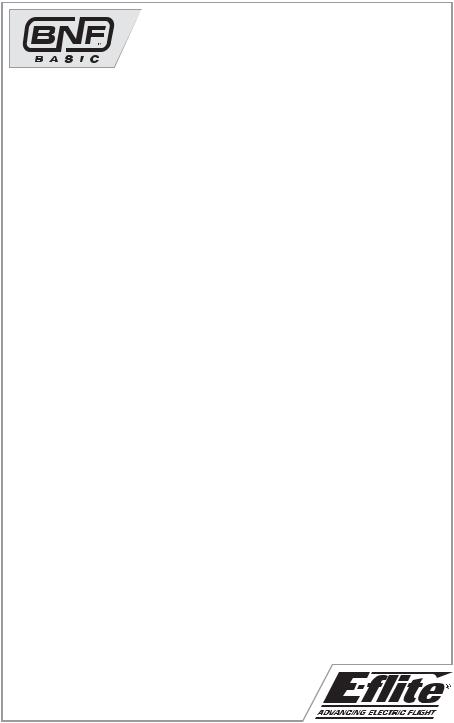
EDGE 540QQ 280
Instruction Manual Bedienungsanleitung Manuel d’utilisation Manuale di Istruzioni
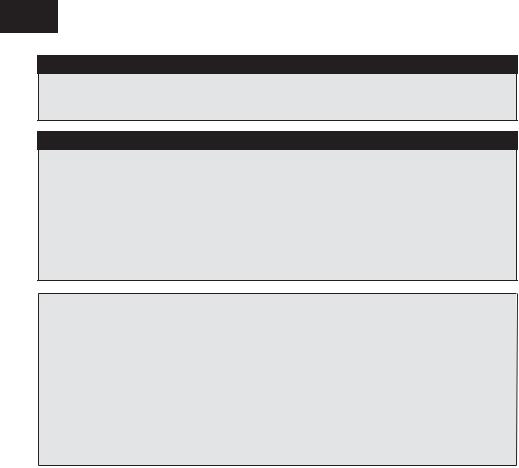
EN
NOTICE
All instructions, warranties and other collateral documents are subject to change at the sole discretion of Horizon Hobby, Inc. For up-to-date product literature, visit www.horizonhobby.com and click on the support tab for this product.
Meaning of Special Language:
The following terms are used throughout the product literature to indicate various levels of potential harm when operating this product:
NOTICE: Procedures, which if not properly followed, create a possibility of physical property damage AND little or no possibility of injury.
CAUTION: Procedures, which if not properly followed, create the probability of physical property damage AND a possibility of serious injury.
WARNING: Procedures, which if not properly followed, create the probability of property damage, collateral damage, and serious injury OR create a high probability of superfi cial injury.
 WARNING: Read the ENTIRE instruction manual to become familiar with the features of the product before operating. Failure to operate the product correctly can result in damage to the product, personal property and cause serious injury.
WARNING: Read the ENTIRE instruction manual to become familiar with the features of the product before operating. Failure to operate the product correctly can result in damage to the product, personal property and cause serious injury.
This is a sophisticated hobby product. It must be operated with caution and common sense and requires some basic mechanical ability. Failure to operate this product in a safe and responsible manner could result in injury or damage to the product or other property. This product is not intended for use by children without direct adult supervision. Do not use with incompatible components or alter this product in any way outside of the instructions provided by Horizon Hobby, Inc. This manual contains instructions for safety, operation and maintenance. It is essential to read and follow all the instructions and warnings in the manual, prior to assembly, setup or use, in order to operate correctly and avoid damage or serious injury.
Age Recommendation: Not for children under 14 years. This is not a toy.
Safety Precautions and Warnings
•Always keep a safe distance in all directions around your model to avoid collisions or injury. This model is controlled by a radio signal subject to interference from many sources outside your control. Interference can cause momentary loss of control.
•Always operate your model in open spaces away from full-size vehicles, traffi c and people.
•Always carefully follow the directions and warnings for this and any optional support equipment (chargers, rechargeable battery packs, etc.).
•Always keep all chemicals, small parts and anything electrical out of the reach of children.
•Always avoid water exposure to all equipment not specifi cally designed and protected for this purpose. Moisture causes damage to electronics.
•Never place any portion of the model in your mouth as it could cause serious injury or even death.
•Never operate your model with low transmitter batteries.
•Always keep aircraft in sight and under control.
•Always use fully charged batteries.
•Always keep transmitter powered on while aircraft is powered.
•Always remove batteries before disassembly.
•Always keep moving parts clean.
•Always keep parts dry.
•Always let parts cool after use before touching.
•Always remove batteries after use.
•Always ensure failsafe is properly set before fl ying.
•Never operate aircraft with damaged wiring.
•Never touch moving parts.
2
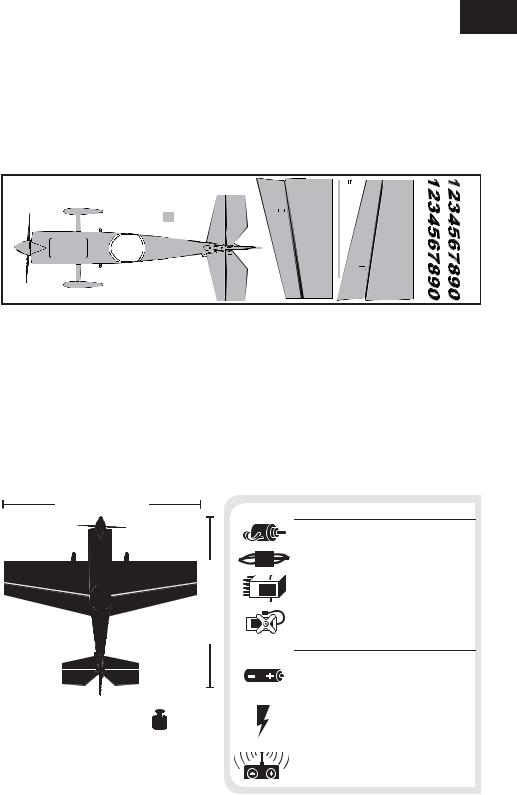
EN
T he E-fl ite® Edge 540QQ 280 BNF Basic, designed by world champion Quique Somenzini, has been specifi cally built to provide exceptional precision scale and 3D aerobatic performance so that you can
fl y from practically anywhere, such as a park or small fi eld. Beyond the advanced composite-reinforced foam construction, you’ll appreciate how its expert-approved control and power system components are installed, making it possible for you to get fl ying faster. Along with your favorite DSM2®/DSMX® compatible transmitter, you can further assure the value of this model is maintained by considering a quality 11.1V Li-Po fl ight battery, such as the E-fl ite® 450mAh 3S 11.1V 30C Li-Po, 18AWG JST (EFLB4503SJ30), and a reliable charger, such as the E-fl ite® Celectra™ 80W AC/DC Multi-Chemistry Battery Charger (EFLC3025).
Please be sure to read through this manual carefully so that you can successfully enjoy all the benefi ts this outstanding E-fl ite model has to offer.
Box Contents
Table of Contents |
|
Low Voltage Cutoff (LVC) ....................................... |
4 |
Transmitter and Receiver Binding ......................... |
4 |
Prefl ight Checklist................................................. |
4 |
Installing the Flight Battery .................................. |
5 |
Arming the ESC .................................................... |
6 |
Installing the Wing ................................................ |
7 |
Control Direction Test ........................................... |
8 |
Control Centering.................................................. |
8 |
Settings for Servo Arms ........................................ |
8 |
Dual Rates and Expos ........................................... |
9 |
Adjusting Center of Gravity (CG) .......................... |
10 |
Applying Decals.................................................. |
10 |
26 in (660mm) |
|
24.1 in (612mm)
8.3oz (235 g)
Removing the Landing Gear................................ |
11 |
Flying Tips and Repairs ....................................... |
12 |
Post Flight Checklist ........................................... |
12 |
Service of Power Components ............................ |
13 |
Troubleshooting Guide ........................................ |
14 |
Limited Warranty ................................................ |
15 |
Warranty and Service Information ....................... |
16 |
Compliance Information for the European Union.. |
16 |
Replacement Parts.............................................. |
62 |
Optional Replacement and Accessories............... |
63 |
Parts Contact Information ................................... |
63 |
Installed |
|
Motor: BL 280 Outrunner Motor, |
|
1800Kv (EFLM7010) |
|
BL Controller, 10A (EFLA7300) |
|
AR6310 DSMX Nanolite 6Ch Rx, Air |
|
(SPMAR6310) |
|
(3) 3.5 g Digital Servo (EFLR7100) |
|
Needed to Complete |
|
Recommended Battery: 450mAh 3S 11.1V 30C LiPo, 18AWG JST (EFLB4503SJ30)
Recommended Battery Charger:
Celectra™ 80W AC/DC Multi-Chemistry
Battery Charger (EFLC3025)
Recommended Transmitter: Full Range
DSM2®/DSMX® with adjustable Dual rate and
Adjustable exponential (DX6I and up)
To register your product online, go to www.e-fl iterc.com
3
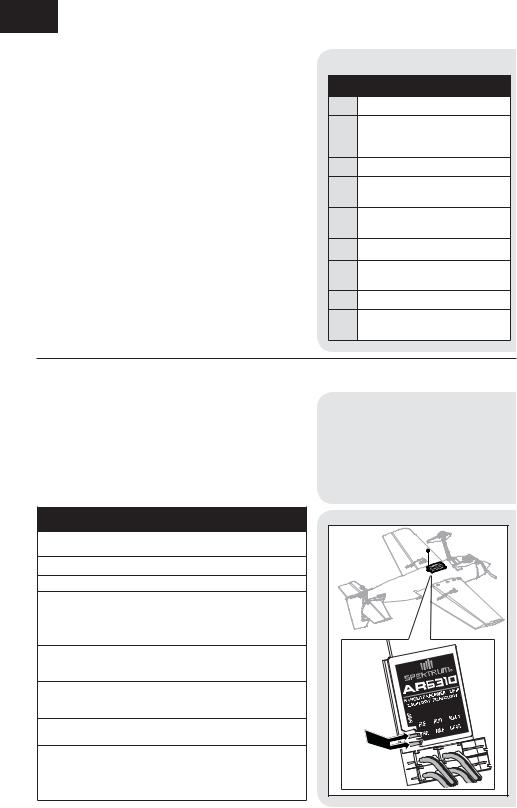
EN
Low Voltage Cutoff (LVC)
When a Li-Po battery is discharged below 3V per cell, it will not hold a charge. The aircraft’s ESC protects the fl ight battery from over-discharge using Low Voltage Cutoff (LVC). Once the battery discharges to 3V per cell, the LVC will reduce the power to the motor in order to leave adequate power to the receiver and servos to land the airplane.
When the motor power decreases, land the aircraft immediately and replace or recharge the fl ight battery.
Always disconnect and remove the Li-Po battery from the aircraft after each fl ight. Charge your Li-Po battery to about half capacity before storage. Make sure the battery charge does not fall below 3V per cell. Failure to unplug a connected battery will result in trickle discharge.
For your fi rst fl ights, set your transmitter timer or a stopwatch to 5 minutes. Adjust your timer for longer or shorter fl ights once you have fl own the model. Flights of 7 minutes are achievable if using proper throttle management.
NOTICE: Repeated fl ying to LVC will damage the battery.
Preflight Checklist
1.Charge fl ight battery.
2.Install flight battery in aircraft (once it has been fully charged).
3.Bind aircraft to transmitter.
4.Make sure linkages move freely.
5.Perform Control Direction Test with transmitter.
6.Adjust center of gravity.
7.Perform a radio system Range Check.
8.Find a safe and open area.
9.Plan fl ight for fl ying fi eld conditions.
Transmitter and Receiver Binding
Binding is the process of programming the receiver
of the control unit to recognize the GUID (Globally Unique Identifi er) code of a single specifi c transmitter. You need to ‘bind’ your chosen Spektrum™ DSM2/DSMX technology equipped aircraft transmitter to the receiver for proper operation.
Any full range Spektrum DSM2/DSMX transmitter can bind to the DSM2/DSMX receiver. Please visit www.bindnfl y.com for a complete list of compatible transmitters.
Binding Procedure
1.Refer to your transmitter’s unique instructions for binding to a receiver (location of transmitter’s Bind control).
2.Make sure the fl ight battery is disconnected from the aircraft.
3.Power off the transmitter.
4.Bind the AR6310 receiver to a DSM2/DSMX transmitter by shorting the bind pins (A) with tweezers, a hemostat or small needle-nose pliers. Metal to metal contact is needed to complete the circuit. Do not bend the bind pins.
5.Connect the fl ight battery to the aircraft. Short the pins until the receiver LED begins to fl ash rapidly (typically after 5 seconds).
6.Ensure that control surface trims are centered and the throttle and throttle trims are in the low position to correctly set the failsafe.
7.Put your transmitter into bind mode. Refer to your transmitter’s manual for binding button or switch instructions.
8.After 5 to 10 seconds, the receiver status LED will become solid, indicating that the receiver is bound to the transmitter. If the LED does not turn solid, refer to the Troubleshooting Guide at the back of the manual.
 CAUTION: When using a Futaba transmitter with a Spektrum DSM module, you must reverse the throttle channel and rebind. Refer to your Spektrum module manual for binding and failsafe instructions. Refer to your Futaba transmitter manual for instructions on reversing the throttle channel.
CAUTION: When using a Futaba transmitter with a Spektrum DSM module, you must reverse the throttle channel and rebind. Refer to your Spektrum module manual for binding and failsafe instructions. Refer to your Futaba transmitter manual for instructions on reversing the throttle channel.
A |
4
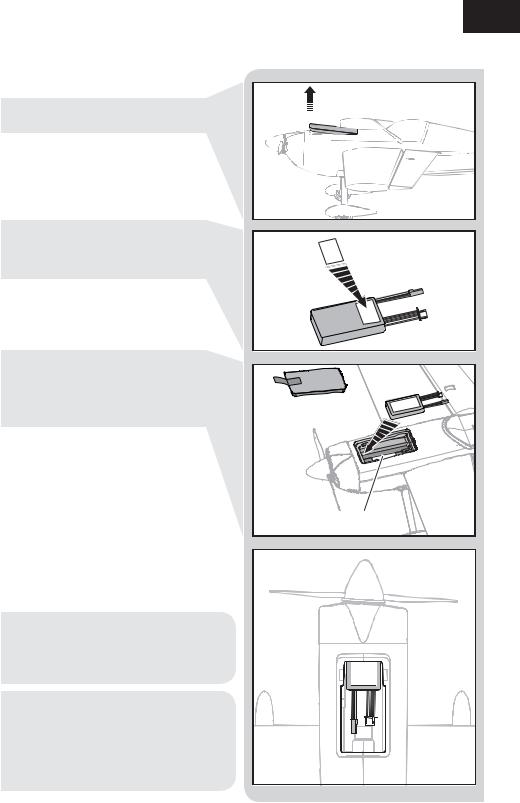
Installing the Flight Battery
1.Remove the battery hatch from the nose of the aircraft.
2.Apply the included strip of hook and loop tape to the bottom of your battery near the battery leads. This position allows easier battery installation and removal.
3.For the recommended CG, install the battery fully forward in the compartment (against the firewall), then press the battery onto the hook and loop strip (A). See the Adjusting the Center of Gravity instructions for more information.
4.Connect a fully charged flight battery to the ESC. See the Arming the ESC instructions for correct connection of the battery to the ESC.
5.Reinstall the battery hatch.
 CAUTION: Always disconnect the Li-Po battery from the ESC when not fl ying to eliminate power supplied to the motor. The ESC does not have an arming switch and will respond to any transmitter input when a signal is present.
CAUTION: Always disconnect the Li-Po battery from the ESC when not fl ying to eliminate power supplied to the motor. The ESC does not have an arming switch and will respond to any transmitter input when a signal is present.
 CAUTION: Always disconnect the Li-Po battery from the ESC when not fl ying to avoid over-discharging the battery. Batteries discharged to a voltage lower than the lowest approved voltage may become damaged, resulting in loss of performance and potential fi re when batteries
CAUTION: Always disconnect the Li-Po battery from the ESC when not fl ying to avoid over-discharging the battery. Batteries discharged to a voltage lower than the lowest approved voltage may become damaged, resulting in loss of performance and potential fi re when batteries
are charged.
EN
A
5

EN
Arming the ESC
Arming the ESC also occurs after binding as previously described, but subsequent connection of a fl ight battery requires the steps below.
Tip: If the ESC sounds a continuous double beep after the fl ight battery is connected, recharge or replace the battery.
If you accidentally connect the battery while the throttle is fully opened, a musical tone will sound after 5 seconds. Disconnect the battery immediately.
 CAUTION: Always keep hands away from the propeller. When armed, the motor will turn the propeller in response to any throttle movement.
CAUTION: Always keep hands away from the propeller. When armed, the motor will turn the propeller in response to any throttle movement.
1
Lower throttle and throttle trim to lowest settings.
 Power on the Transmitter.
Power on the Transmitter.
2
Remove the magnetic battery hatch and install the fl ight battery to the hook and loop strip, then connect the battery to the ESC, noting proper polarity.
3

 Series of tones
Series of tones
Continuous LED
6
